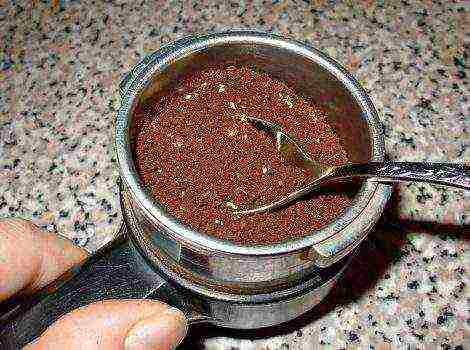Content
- 1 Roses by David Austin - a long way to the success of what you love
- 2 New items from David Austin kennel
- 3 Austin roses: popular varieties for growing in the middle lane
- 4 Selected and popular all over the world varieties
- 5 Interesting varieties that do not grow in the Moscow region
- 6 How to pair Austin rose varieties in gardens
- 7 What varieties are considered the best overall?
Flowers in the life of a summer resident or gardener occupy their own, separate, niche. Many people prefer the rose. She is considered the queen of flowers and is appreciated for its unique look, shape and aroma. Thanks to the desire of gardeners for new achievements in the field of flower breeding, completely new species of this wonderful plant are created, which are unique, graceful and incredibly beautiful. These are the characteristics that the roses of David Austin are endowed with. They concentrate the best qualities taken from long-existing varieties. They have their own flavor, and almost everyone likes them.
Roses by David Austin - a long way to the success of what you love
The history of the emergence of this type of roses is very interesting. It should be noted that a person gave all his strength and knowledge for the benefit of the appearance of unique flowers. The beginning of the difficult path of breeding the first Ostins was laid in England in the 50s of the twentieth century.
When a young amateur florist named David Austin returned from a trip to Europe, he wanted to create original varieties of roses, which in the future will be positioned as David Austin's English roses. The encyclopedia of roses will be replenished with new varieties, and they will enjoy great success.
He was literally captivated by the beauty of these flowers, but the fact that most of the varieties he saw bloomed only once a season and not for long, he was a little upset. Then David decided to combine all the advantageous qualities and discard the disadvantages. And he devoted his whole life to this.
In practical research, Austin used existing varieties that were not very popular. The basis was tea-hybrid, floribunda, Damascus and French. As a result of crossing hybrid tea, large-flowered re-flowering varieties, and old, sophisticated, resistant and not whimsical once-flowering varieties, David Austin managed to breed the original rose, which was named Constance Spry. It was she who became the beginning of the long path of the English breeder.
Constance Spry was about half a century old, but to this day it is quite popular. She became the basis for future new varieties of roses by David Austin (see photo). First introduced to the Constance Spry by a friend of the English breeder, Graham Thomas in 1961. It can be classified as climbing roses, although a beautiful bush can be formed if the shoots are carefully trimmed. In this case, you will get an excellent garden bush, up to 2 m high. A characteristic feature of most varieties of D. Austin's roses are fragrant, large flowers. So in Constance Spry their diameter can reach 15 cm. The buds are collected in neat brushes. Their shape is cupped. The flowers themselves, as if not fully opened. They bloom on stems, the length of which can reach 6 m. The foliage of these flowers is light green with a matte shade. Shoots have thorny thorns. It blooms only once in July. This quality did not suit the grower. In addition, the variety required careful protection from diseases and pests.
The work continued. He was looking for new approaches. Only after the third backcrossing of the main variety with the hybrid, almost all varieties (seedlings) of Austin roses inherited the duration of flowering.
Also, the English breeder was worried about the problem of the endurance of new plants. During the 60s, it was not possible to create decent resistant varieties. In the early 70s, David was able to breed disease resistant roses.The very first variety endowed with such qualities is The Mayflower. This is a versatile Austin rose variety that many gardeners have been looking for. During the years of cultivation, no signs of any disease were noticed on the foliage of this plant. In this regard, The Mayflower was awarded a royal award, namely, received a quality seal from the British Royal Horticultural Society.
In addition to The Mayflower, other varieties of Austin's English roses received the same award:
In 1969, David Austin Roses was established. This event was marked by the receipt of a whole series of scrub hybrid roses, the flowers of which had double petals. Wife of Bath was recognized as the best plant in the Austin Rose Nursery of this series.
While the newly-minted company was gaining momentum, work on improving the quality characteristics did not stop for an hour. The year 1983 was truly life-changing. In the suburb of London, which is called Chelsea, a flower exhibition was held, which presented the best varieties of Austin roses - Mary Rose and Graham Thomas. They have gained great popularity not only in England but throughout the world. Since then, Austin's roses (see photo) have become world famous, unique and recognizable.
In the 21st century, the management of the company was transferred to the son of a famous English breeder. The territory of the nurseries is in the open air. This is a real flower-growing museum, where you forget about everything in the world, and just admire the incredible beauty and abundance of varieties of roses (more than 200 varieties are concentrated).
Today it is not difficult to buy seedlings of Austin English roses and seed material. There are many shops on the Internet that provide an opportunity for interested flower growers to grow beautiful varieties. Each year, David Austin Rose Nurseries produce about 4-6 new varieties of these flowers. Branches of the company are located in all parts of the world. They have about 4.5 million seedlings.
Officially, English roses are not bred into a separate group, but behind the scenes, Ostinki are considered the hallmark of British floriculture. Most of D. Austin's varieties are bush roses (shrubs). The selection of the company "David Austin Roses" includes several climbing:
They are used to create a unique landscape design for a summer cottage or private houses.
Great attention should be paid to two unique varieties of David Austin roses (the catalog displays them as "the best of the best"). The peculiarity is that they bloom very slowly and in a semi-release resemble hybrid tea roses. A characteristic feature is the rigidity of the petals and the severity of the forms. Inflorescences are large-flowered. They are resistant to adverse weather conditions and many diseases.
The best roses of David Austin:
Austin's peony roses also stand out:
Red varieties:
David Austin Cream Peony Roses:
What is the difference? Firstly, the bushes reach over one and a half meters in height. Secondly, on one brush, there are up to 8 large (up to 14 cm in diameter) flowers. They are very fragrant and uniquely beautiful.
The best varieties of roses selected by David Austin for container or flowerpot growing at home:
There is also one of the best breeding developments in the company's catalog, which is endowed with resistance to extreme cold. This is an Austin rose (winter hardy variety) called Snow Goose. It is characterized by small white flowers, collected in large clusters. The petals are of different lengths and grow, as it were, in layers. This plant should be classified as climbing, abundantly flowering varieties. Although summer residents note that if you wish, you can form a good bush.
In addition to Snow Goose, there are other Austin most winter-hardy roses:
New items from David Austin kennel
Constant novelties, which are displayed in nurseries of Austin English roses, immediately become popular among fans of the famous breeder's rose garden.
The freshest (new) varieties of David Austin:
- Dezdemona... Refers to park views. A characteristic feature is a rich pink-peach shade and rounded bushes, up to 1.2 m high. Very fragrant, its heady scent spreads throughout the garden. The flowers are large, at first they have a white tint, but over time they acquire a peach tone. The foliage is glossy green, saturated. This plant has excellent flowering continuity. Almost without interruption, it pleases with its unique flowers. They make bouquets of roses well. David Austin can only be thanked for such a wonderful plant.
- The Albrighton Rambler (The Albrighton Rambler). Belongs to Austin climbing varieties. The incredible beauty of this plant is simply mesmerizing. This Austin rose (see photo) has a light nutmeg scent and it blooms for a long period, up to frost. It is resistant to many diseases.
- Olivia Rose Austin (Olivia Rose Austin). The names of Austin roses are always confined to something or dedicated to any personality that takes place in the life of the breeder. Olivia Rose Austin is no exception. It was named after the granddaughter (daughter of the eldest son). The flowers grow large and beautiful, the bushes are of the correct shape. The scent spreads throughout the garden with fruity notes. It should be noted that the plant blooms very early and blooms continuously. Olivia Rose Austin is resistant to many diseases. Some summer residents note that it is also Austin's winter-hardy rose.
- The Poet's Wife Translated from English means the Poet's Wife. Very beautiful new product of 2016. This Austin double rose (see photo with the name) has a yellowish tint and a complex rosette of flowers. It blooms for a long time, without interruption. Shoots form large, dense, rounded bushes, about a meter high. The aroma is very intense. It has notes of lemon and peach. In continuous flowering beds, can be planted in the foreground. The Poet's Wife rose has a really alluring look and a great aroma that inspires creativity.
- The Ancient Mariner One of the latest novelties, which was released in 2017. The peculiarity of flowering is remarkable. Densely double, large flowers bloom slowly, revealing the incredible beauty of the inside. This is a two-color Austin rose, at first it has delicate lilac petals, and then the inner leaves of saturated shades appear. The bush can reach a height of one and a half meters. The Ancient Mariner is a continuous flowering cultivar. It is used for growing in parks and summer cottages.
David Austin's company never stops developing new, unique varieties. The ship, called David Austin Roses, continues its voyage, and its flowers are rapidly gaining popularity.
The best varieties of roses D. Austin, video
Englishwomen in Russian gardens
Restrainedly elegant with a refined aroma, David Austin's English roses are known throughout Europe. Many of the breeder's varieties have received high-level awards. Bred in the temperate climate of Great Britain, Austin roses quickly adapted in Russia and thrive in the Moscow region. And in the more favorable conditions of the south of the country, thorny beauties demonstrate increased strength of growth, climbing the walls of houses and gazebos.
Not all Austin varieties are recommended for Russia, but those that are approved for sale show high winter hardiness and endurance. They are undergoing variety testing in experimental plots in the USA and Scandinavia.
Austin rose varieties have the following common characteristics:
- versatility and sophistication of aromas from myrrh to polysyllabic fruity;
- specific cup-shaped bud;
- the predominance of peach, pale pink, white and yellowish shades - according to D. Austin, forms with a red color of flowers show less endurance and it is more difficult to get a good strong red hybrid;
- repeated or continuous flowering;
- have "star" names and reflect the cultural history of England;
- are distinguished by their unpretentiousness and high vitality;
- large and heavy flowers often droop on thin shoots.
All Austin roses are beautiful. But we tried to include in our rating those varieties of English roses that (according to gardeners' reviews) showed themselves best in difficult domestic climatic conditions.
|
Lady of Shalott 1,700 (seedling from D. Austin nursery in a branded package) Austin's best rose for beginner growers. The variety is striking in frost resistance, endurance and disease resistance. Unblown buds are bright orange in color. Flowers 8-10 cm in diameter, double, cupped, salmon-colored with a golden glimpse. 1 to 3 flowers are laid on one stem. Fruit-tea aroma with notes of apple and clove, well expressed. Flowering is constant, without interruption. The rose blooms well even in cold and rainy summers. The flower lasts 5 - 10 days, and by the end of its flowering a new shoot with a bud grows from the axillary bud. With proper planting and good care, it blooms in the first year. In the first year, flowers can be single and smaller in diameter, the bush is gaining strength by the 3rd season. The bush is vigorous, highly branched, with flowing shoots. The size of the bush in height and width is about 1 m, but in the south the bush can grow up to 2 m. It is successfully grown in the Moscow region and Western Siberia. Hibernates under a lutrasil shelter. In the heat, it experiences stress, the flowers fade faster. Main pluses:
Minuses:
|
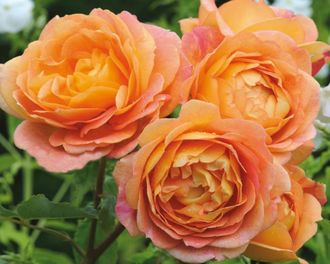 9.9 / 10 Rating Reviews It blooms and grows very actively. The three-year-old bush amazes with its endurance. I love this Ostinka for its nostalgic shape and original color of the flower.
|
|
Golden Celebration 590 (2-year-old seedling in a bag with wet peat mixture) The variety is notable for its large, densely double copper-yellow flowers up to 16 cm in diameter. Bright yellow petals with small pink specks. Cupped shape with bent rounded petals. A sophisticated combination of an old form with a modern original color. Pronounced sweet-fruity aroma. On one shoot from 3 - 5 to 10 flowers. Flowers fade in 5-6 days, but fly around faster in hot weather. In a temperate climate, the height of the bush does not exceed 1.5 m, but in the south of Russia Golden Celebration can be grown as a climbing rose. The arcuate shoots of the ostinka droop under the weight of the flowers, there are not many thorns. The winter hardiness of the variety is average, grown with shelter. Good resistance to diseases, but with a massive spread of the pathogen in the region, preventive treatments are carried out. Main pluses:
Minuses:
|
 9.7 / 10 Rating Reviews My favorite Austin rose, I think - the best English rose. The flowers do not last long, but the flowering is so abundant that the bush is always strewn with flowers. Under the large flowers, the shoots, of course, droop, but this is rather a feature of the ostins.
|
|
Graham Thomas 890 (seedling in a container) One of the best representatives of yellow English roses. Flowers up to 10 cm in diameter, warm rich yellow, pale in the sun, convexly cupped, peony-shaped, double (up to 75 petals), with a strong sweetish tea aroma. On one shoot, from 3 to 5 flowers are laid. The flower lasts up to 5 days, in hot weather it flies around faster (in 1 - 3 days). In temperate climates, the bush reaches 1.5 m, and in hot climates, it is grown like a climbing rose, letting 3-meter shoots along the support. To form a thick shrub, the shoots are cut off after the first flowering, provoking abundant branching. If the bush is not disturbed, the shoots will stretch along the support. Shows average winter hardiness and good disease resistance, preventive treatments are required. Good results were noted in the Volga region. Main pluses:
Minuses:
|
 9.5 / 10 Rating Reviews The first year you need to give the seedling to gain strength and then it will delight you with good flowering. My rose grows in partial shade, and the flowers are brighter in color.
|
|
Molineux 350 (seedling with an open root system in a bag with a wet substrate) The variety stands out from other achievements of D. Austin in appearance. The bush is upright, not drooping, with a narrow crown. If other ostinki are ideal in single plantings, then Molyneux is recommended to be planted only in groups. The declared height of the bush is about 0.65 m, although in the southern regions the "baby" can reach 2 m. Flowers are densely double (up to 120 petals), 6 - 8 cm in diameter, in the form of a cupped rosette, collected in racemose inflorescences of 3 - 5 pcs. The color of only blossoming flowers is golden with an apricot tint, and under the sun it fades to lemon and cream at the edges. Blooms all season. Since there are flowers of different ages with a changing color at the same time, the bush effectively shimmers with shades of yellow. Flowers fly around quickly, but the bush always remains in bloom. There is a delicate aroma of tea roses with musky notes. According to frost resistance, the variety belongs to zones 5 and 6. In the suburbs, it requires shelter. In cool climates, it forms larger flowers, and in hot climates, the color is revealed brighter. Main pluses:
Minuses:
|
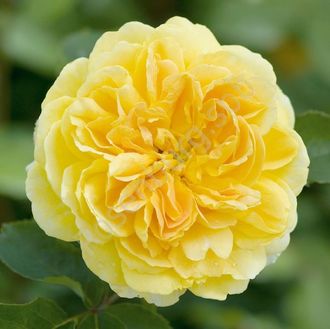 9.5 / 10 Rating Reviews Expressive and harmonious English rose. Constantly surprises with a variety of shades. She is not capricious in her care, with good health.
|
|
Mayflower (The Mayflower) 1,190 (3-year-old seedling in a container) The variety is fully consistent with a typical English rose. The buds appear earlier than other varieties, and flowering lasts until late autumn, without losing abundance. The flowers are rosette-shaped, strongly double (75 - 90 petals), small, 6 - 8 cm in diameter, even pink in color, with the classic scent of rose oil, the petals are slightly bent down. The flower lasts 7 or more days. The bush is lush, but compact, it grows gradually. Shoots are densely covered with small leathery leaves, there are very few thorns. In landscape design, it is used for planting in the foreground. Has excellent winter hardiness, feels better in cool climates. Main pluses:
Minuses:
|
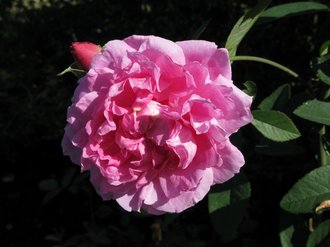 9.3 / 10 Rating Reviews Delicate, but at the same time very healthy rosette. In the first years, it gives a very small increase, but in the future a dense bush is formed.
|
Austin roses are predominantly bushy and spreading. They amaze with stamina and natural grace. English roses are good both as tapeworms and in group plantings. Delicate calm shades allow you to easily combine all Austin varieties in one flower bed, while maintaining the harmony and sophistication of the garden. They were created for gardens in a natural, natural style.
Of course, our rating is far from complete. Each rose grower has its own favorites, and any variety has at least one bad experience and disappointment on the account. But the joy of blooming roses makes you forget about failures.
Happy choice!
Attention! The reliability of the information and the results of the ratings is subjective and does not constitute advertising.
For cultivation in the suburbs of Moscow, English roses are considered one of the best crops. They appeared as a result of crossing old roses with roses of the floribunda group of varieties and modern hybrid tea varieties.Which ones should you prefer for your garden? Which of the varieties are considered the most popular?
Austin roses: popular varieties for growing in the middle lane
- Variety Charles Austin was bred in 1973 but is still popular today. Semi-veneered scrub or shrub suitable for vertical and horizontal landscaping. The rose is unpretentious, resistant to rain, hibernates in the middle lane with shelter. Blossom with fragrant double buds of a delicate apricot color. The plant is hardy, survives safely even on not very fertile soils, it is resistant to diseases and pests. Its only drawback is the untidy appearance of old buds against the background of young ones. Heavy rain will aggravate the situation, alas, this rose does not like prolonged precipitation. Judging by the reviews of those who grow this variety of roses, in a particularly wet season, it loses not only external beauty, but can also get sick with black spot.

Charles austin
- Alexandra Kent - a profusely flowering variety of roses, which may need to be tied with whips during the peak flowering period. Pink dense double buds last for a long time, look harmonious on flower beds, hedges and borders, as well as in containers. Those who grow the rose speak of it as a strong healthy culture that is not affected by any diseases; in rare cases, powdery mildew can be found on it, but in insignificant quantities. The title photo also shows this variety.
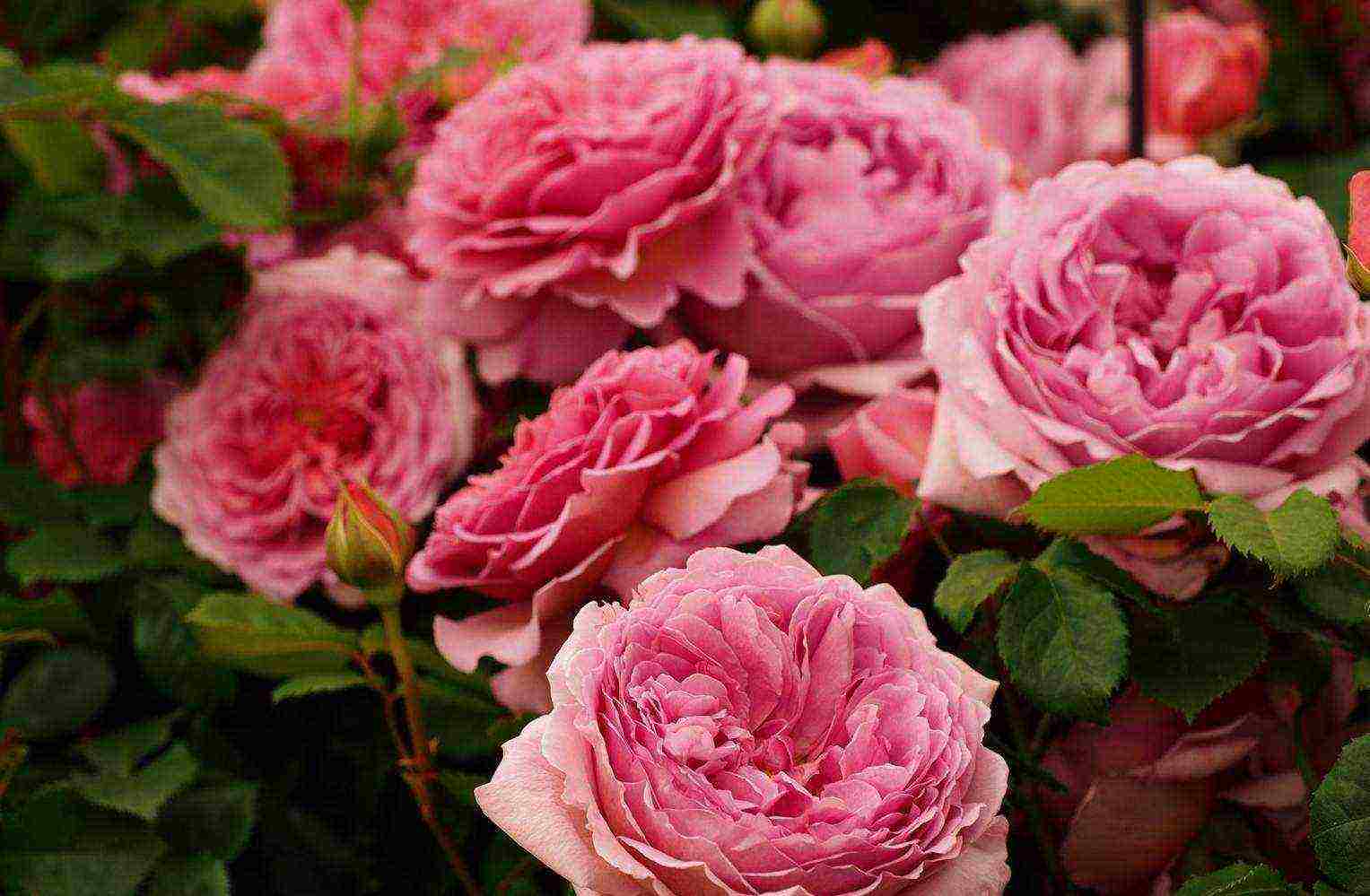
Alexander kent
- Crown Princess Margaret Is a climbing rose variety with large orange-apricot inflorescences, blooming from May to November. For normal flowering and growth, it needs to be planted in sunny places, where there are no other shrubs and trees within a radius of 1-2 m. The culture loves loose soft soils and moderate abundant watering and does not tolerate waterlogging and acidic soils. The variety is frost-resistant, tolerates high humidity and is immune to disease.

Crown Princess Margareta
- Roses Claire Austin, bred in 2007, are considered the best white English roses, blooming in large creamy white buds. The hybrid tea culture grows as a bush, but its shoots with a support can stretch up to 2.5 m, which allows it to be grown as a climber or climbing rose. The flower is resistant to disease, but in cold winter it needs additional shelter, as it can withstand temperatures as low as -10 ° C. In summer, the rose tolerates heat well, with regular watering and loosening, it grows well and blooms at temperatures up to + 40 ° C. Suitable for growing in flower beds and in mixborders, as a curly version is planted near fences, arches, walls and columns.

Rose claire austin
- A new variety of roses was introduced in 2014 Olivia Rose, reviews of which are only positive. The crop is very disease resistant, resistant to powdery mildew and black spot. It blooms profusely and wavy, blooming one of the first and shedding buds in late autumn. The rosette inflorescences smell fragrant, look good in flower beds, are suitable for growing in containers or for forming hedges. Photo of a plant on the site:

Olivia rose
Important! To re-eject the buds, regardless of the type of rose, after the first flowering, the bushes must be cut and fed.
Selected and popular all over the world varieties
The description of Austin rose varieties will be incomplete if you do not mention the popular varieties popular among those who grow roses in their backyards:
- Roses William Shakespeare 2000 were first bred in 1987 and as the reviews confirm, the variety is enviable popularity. A tall upright bush with spherical carmine-red buds will decorate the landscape, bloom in waves, all season. If the weather is warm, after a break in August, the plant blooms again by September. The plant loves warm light areas, slightly on a hill, but protected from drafts.It grows well and blooms on fertilized soils, is moderately resistant to disease, and needs insulation for the winter.
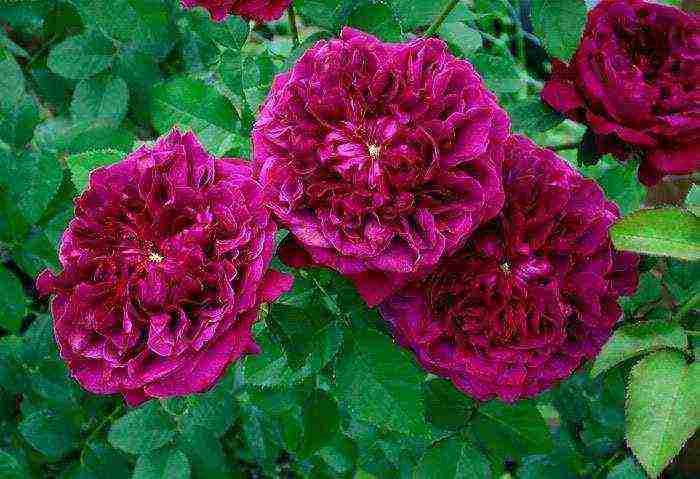
William Shakespeare 2000
- Golden Celebration, long and profusely blooms with dense inflorescences of yellow-lemon color from May to October. The bushes are resistant to frost, wind and rain. Loves regular pruning and feeding, needs moderate watering and loosening the soil around the roots.
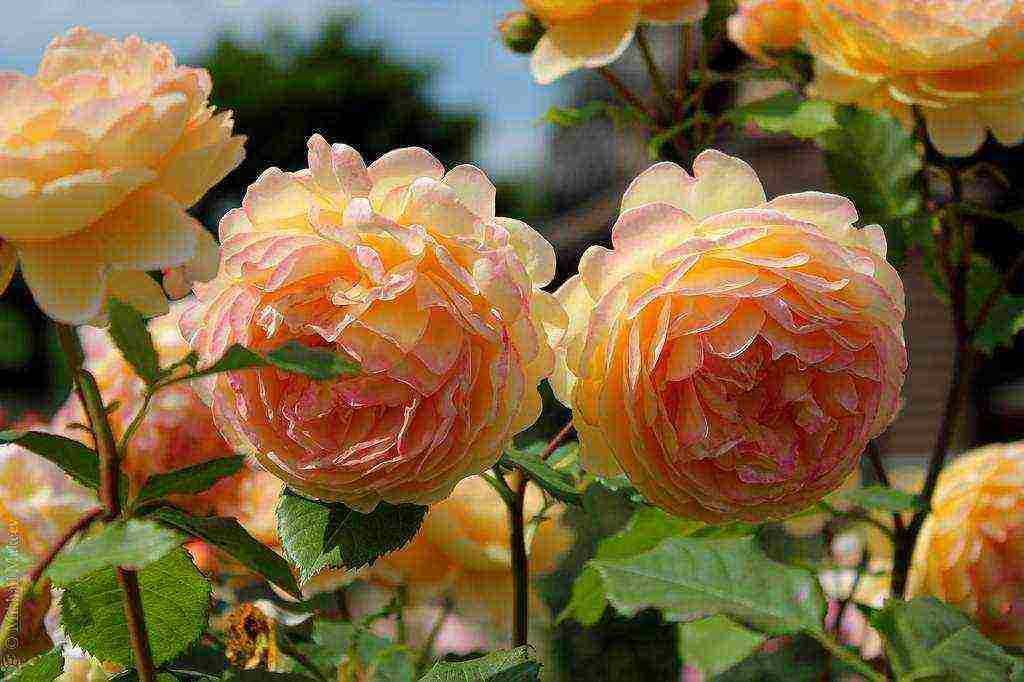
Golden Celebration
- Mary Rose - a variety that is indispensable for those who prefer crops growing in a wide spreading bush with an abundance of peduncles. The flower is strong and powerful, resistant to pests and diseases, tolerates winter well and is one of the first to bloom with the onset of warm days.

Mary rose
- Leonardo da Vinci - a good variety for flower beds and rose gardens. The popular scrub is distinguished by abundant flowering up to frost, it is resistant to precipitation and the scorching sun. Under favorable conditions of care and warm weather, the bush grows up to 2 m high, abundantly throwing out peduncles. The plant does not require special care and is resistant to diseases, including black spot.

Leonardo da Vinci
- Gertrude Jekyll Is another popular variety that attracts with frost resistance, hardiness to adverse conditions and abundant flowering. The bush should be regularly fed and pruned, otherwise it will stop blooming. For re-blooming, it is also worth constantly removing the fading buds. Of the shortcomings, it is considered important that the culture is prone to black spot. But this is the only disease to which the rose is susceptible.
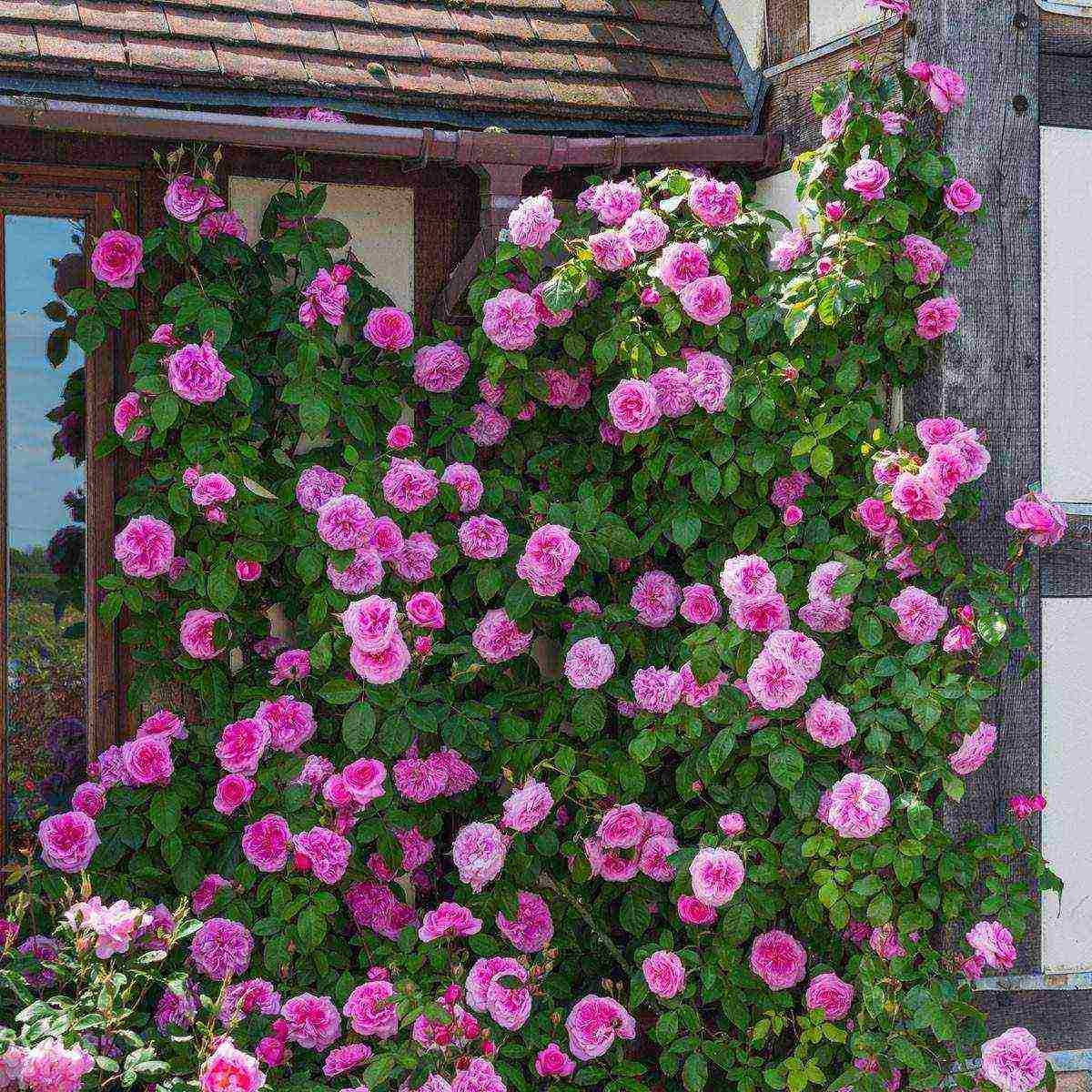
Gertrude Jekyll
Interesting varieties that do not grow in the conditions of the Moscow region
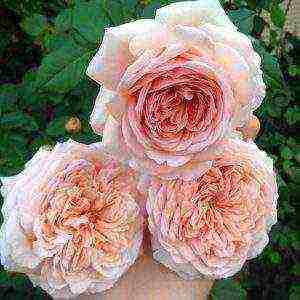
Abraham derby
The enemy, especially masquerading as a delicate beauty with lush flowers, must be known by sight. Even the best varieties of English roses are not always suitable for growing in the middle lane. The fact is that in the climate of the Moscow region, diseases interfere with normal growth and development of crops: powdery mildew and black spot. For example, varieties such as Abraham Derby, Charles Darwin, James Galway, William Morris vulnerable to moisture and rain. If the season is rainy, dense buds do not bloom, the stuck together petals prevent flowering and even begin to rot. Rust begins to appear on the bushes, which can very quickly infect the entire rose garden.
This is not the only minus of English beauties, reviews on varieties of practicing gardeners in the Moscow region. For example, varieties Sharifa Asma, Pat Austin, Saint Cecilia susceptible to high temperatures and do not tolerate scorching heat. If the air temperature rises to + 28-30 ° C, the buds that have blossomed in the morning fall off profusely by the evening. In general, the bush begins to wither, the flowers become smaller and fade very quickly, losing their presentable appearance.
Practicing gardeners also noted the following features of some Ostinka varieties:
- The root system of the Lady Shallot and Crocus Rose varieties should be kept in humate for 6-7 days before planting. This guarantees vigorous growth and abundant flowering of the bushes.
- Golden and Mary Rose, on the contrary, need short-term exposure to growth stimulants, overexposure, on the contrary, inhibits the growth and development of the plant.
- Most varieties of English roses do not tolerate drafts, grow poorly and bloom in lowlands, where the soil is quickly swamped and irregularly ventilated. Ostinks also grow poorly in landscapes where groundwater lies close to the surface.
- It is good when the soil is light, loose and oxygenated. In them, the English rose feels comfortable, is less sick and blooms profusely. If the soil is dense, peat or sand is added to it to provide breathing for the root system.
It is recommended to plant crops in spring or autumn, but before the first frost. When planting in the spring in the fall, you need to dig up and fertilize the soil so that the bush quickly takes root and hurts less in the future.
How to pair Austin rose varieties in gardens
The combination of rose varieties with each other and with other crops is an important aspect of garden planning. What does David Austin say about landscape aesthetics? Here's what he advises for those planning to break the rose garden:
- If you plan to grow roses for landscape design, do not spray and buy many varieties. This is appropriate when a rose garden is needed for breeding and growing crops for export.
- To make the roses look spectacular, each variety is planted in small groups, about three copies at a distance of 0.5-0.75 m from each other. If the bushes have a vertical narrow crown, the distance can be reduced to 0.3 m.
Interesting information! The gardeners of the Moscow region have a different opinion on this matter. They often recommend planting bushes at a distance of about a meter from each other. As long as the plants are small, the free space is filled with low-growing crops, one or perennials.
- Austin roses of different varieties go well with each other. The soft colors of the buds are in harmony with each other, but do not combine with cultures of variegated bright colors.
- The best neighbors for them will be perennials, compact, without spreading lashes, powerful stems and large buds. The optimal cultures are those that will set off and complement the beauty of the rose, and not compete with it.
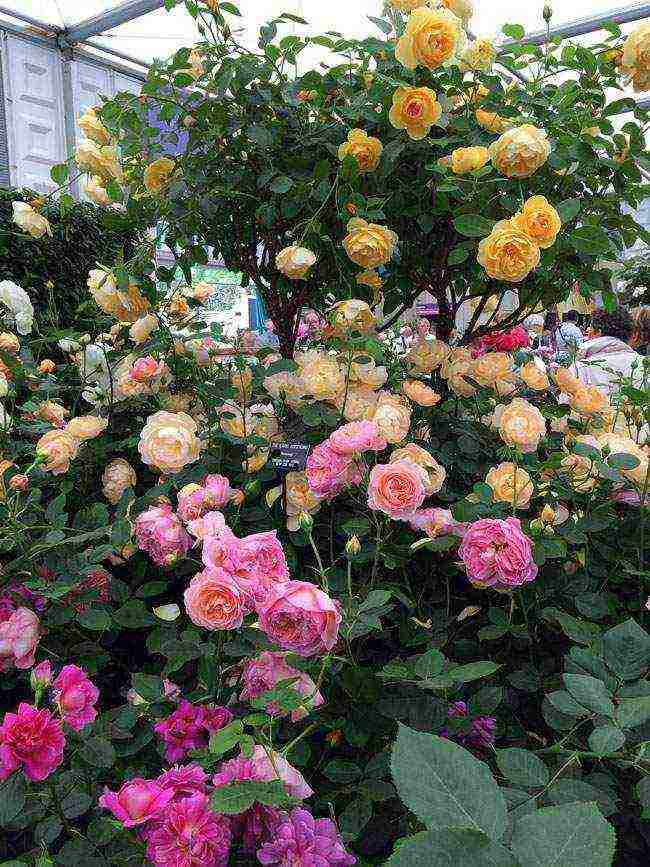
Combination of varieties of roses
Spring pruning is important for the abundant flowering of roses of any variety. It doesn't matter what it will be: a simplified pruning with a simple shortening of the shoots by ½ the height, or a complex one, done according to all the rules. Regular rejuvenation activates the growth of the bushes and guarantees abundant flowering. Feeding is no less important, especially if the soil is not fertile. A regular supply of nutrients ensures that the crop grows vigorously, blooms profusely, and acquires immunity from disease.
And finally, a little beauty: the roses of D. Austin in our gardens in the photo.
What varieties are considered the best overall?
The video below is a selection of the generally recognized best varieties of roses by David Austin.


